Maximilian Pietsch1, Alison Ho2, Alessia Bardanzellu1, Aya Zeydan1, Joseph V Hajnal3, Lucy Chappell2, Mary A Rutherford3, and Jana Hutter1,4
1Centre for Medical Engineering, King's College London, London, United Kingdom, 2Women's Health, King's College London, London, United Kingdom, 3King's College London, London, United Kingdom, 4Centre for the Developing Brain, King's College London, London, United Kingdom
1Centre for Medical Engineering, King's College London, London, United Kingdom, 2Women's Health, King's College London, London, United Kingdom, 3King's College London, London, United Kingdom, 4Centre for the Developing Brain, King's College London, London, United Kingdom
Fully automatic artificial-intelligence population-based quantification of placental maturation and health from a rapid 30sec functional Magnetic Resonance scan is shown in >100 women to correlate with low birth weights, spontaneous premature birth and histopathological results.

Figure 1: The proposed pipeline for the automatic placental maturation assessment is depicted consisting of the data acquisition, automatic segmentation used to calculate the placental mean T2* and the Gaussian Process regression fit or prediction, which is used to characterize placental health. All parts are discussed in the methods section.

Figure 5: Top: The placental health Z-scores are strongly related with degree of prematurity measured as GA at birth (right) and extremely low birth weight centile (left). Bottom: Z-scores grouped by histopathological examination results color-coded by GA at birth. Participants with maternal vascular malperfusion (MVM) exhibit lower Z-scores and belong to the group delivered prematurely. Chorioamnionitis does not affect Z-scores in control cases but seems to correlate to normal Z-scores in high-risk participants.
